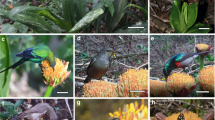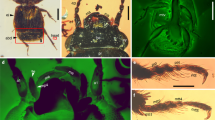Abstract
Most lineages in the African genus Protea consist of species with large unscented flowers pollinated principally by birds, and several of these lineages also show evidence of shifts to rodent pollination, associated with concealed yeasty-scented flowerheads. In this study we investigated the hypothesis that brightly coloured and fruity-scented flowerheads of four Protea species (P. caffra, P. simplex, P. dracomontana and P. welwitschii) represent a novel shift from bird to insect pollination in a grassland lineage in the genus. These species are visited by a wide range of insects, but cetoniine beetles were found to be the most important pollinators because of their abundance, size and relatively pure pollen loads. Three of the four putatively insect-pollinated Protea species have flowers presented at ground level, and experiments showed that cetoniine beetles preferred inflorescences at ground level to those artificially elevated to the height of shrubs and small trees. Relative to insects, birds were infrequent visitors to all of the study species. The nectar of all the study species contained xylose, as documented previously in bird- and rodent-pollinated Protea species, suggesting that this is a phylogenetically conserved trait. However, the very low concentration of nectar (ca. 8%), short nectar-stigma distance and the fruity scent of florets appear to be traits that are associated with specialisation for pollination by cetoniine beetles.



Similar content being viewed by others
References
Armstrong JE, Irvine AK (1989) Floral biology of Myristica insipida (Myristicaceae), a distinctive beetle pollination syndrome. Am J Bot 76:86–94
Beattie AJ (1971) A technique for the study of insect-borne pollen. Pan-Pacific Entomol 47:82
Bernhardt P (2000) Convergent evolution and adaptive radiation of beetle-pollinated angiosperms. Plant Syst Evol 222(1–4):293–320
Bernhardt P, Weston PH (1996) The pollination ecology of Persoonia (Proteaceae) in eastern Australia. Telopea 6:775–804
Carlson JE, Holsinger KE (2010) Natural selection on inflorescence color polymorphisms in wild Protea populations: the role of pollinators, seed predators, and intertrait correlations. Am J Bot 97(6):934–944
Carolin R (1961) Pollination of the Proteaceae. Aust Mus Mag 13:371–374
Chalcoff VR, Ezcurra C, Aizen MA (2008) Uncoupled geographical variation between leaves and flowers in a South-Andean Proteaceae. Ann Bot 102:79–91
Coetzee JH, Giliomee JH (1985) Insects in association with the inflorescence of Protea repens (L.) (Proteaceae) and their role in pollination. J Entomol Soc Southern Africa 48(2):303–314
Collins BG, Rebelo T (1987) Pollination biology of the Proteaceae in Australia and southern Africa. Aust J Ecol 12:387–421
Dieringer G, Cabrera L, Lara M, Loya L, Reyes-Castillo P (1999) Beetle pollination and floral thermogenicity in Magnolia tamaulipana (Magnoliaceae). Int J Plant Sci 160(1):64–71
Englund R (1993) Movement patterns of Cetonia beetles (Scarabaeidae) among flowering Viburnum opulus (Caprifoliaceae): option for long-distance pollen dispersal in a temperate Shrub. Oecologia 94(2):295–302
Faegri K (1965) Reflections on the development of pollination systems in African Proteaceae. J South African Bot 31:133–136
Faegri K, van der Pijl L (1979) The principles of pollination ecology. Pergamon, Oxford
Field A (2009) Discovering statistics using SPSS, 3rd edn. SAGE, Los Angeles
Gess FW (1968) Insects found on Proteas. J Bot Soc South Africa 54:29–33
Goldblatt P, Manning JC (2006) Radiation of pollination systems in the Iridaceae of sub-Saharan Africa. Ann Bot 97(3):317–344
Goldblatt P, Bernhardt P, Manning JC (1998) Pollination of petaloid geophytes by monkey beetles (Scarabaeidae:Rutelinae:Hopliini) in southern Africa. Ann Missouri Bot Gard 85(2):215–230
Gottsberger G (1990) Flowers and beetles in the South-American tropics. Botanica Acta 103(4):360–365
Gross CL, Caddy HAR (2006) Are differences in breeding mechanisms and fertility among populations contributing to rarity in Grevillea rhizomatosa (Proteaceae)? Am J Bot 93(12):1791–1799
Hanley ME, Lamont BB, Armbruster WS (2009) Pollination and plant defence traits co-vary in Western Australian Hakeas. New Phytol 182(1):251–260
Hargreaves AL, Johnson SD, Nol E (2004) Do floral syndromes predict specialization in plant pollination systems? An experimental test in an “ornithophilous” African Protea. Oecologia 140(2):295–301
Hosmer DW, Lemeshow S (2000) Applied logistic regression, 2nd edn. John Wiley and Sons, New York
Howe HF, Westley LC (1988) Ecological relationships of plants and animals. Oxford University Press, New York
Johnson SD, Andersson S (2002) A simple field method for manipulating ultraviolet reflectance of flowers. Can J Bot 80(12):1325–1328
Johnson LAS, Briggs BG (1975) On the Proteceae—the evolution and classification of a southern family. Bot J Linn Soc 70:83–182
Johnson SD, Steiner KE (2003) Specialized pollination systems in southern Africa. S Afr J Sci 99(7–8):345–348
Johnson SD, Ellis A, Dotterl S (2007) Specialization for pollination by beetles and wasps: the role of lollipop hairs and fragrance in Satyrium microrrhynchum (Orchidaceae). Am J Bot 94(1):47–55
Kalinganire A, Harwood CE, Slee MU, Simons AJ (2001) Pollination and fruit-set of Grevillea robusta in western Kenya. Austral Ecol 26(6):637–648
Lamont B (1982) The reproductive biology of Grevillea lecopteris (Proteaceae) including reference to its glandular hairs and colonizing potential. Flora 172:1–20
Lamont B (1985) The significance of flower colour change in eight co-occurring shrub species. Bot J Linn Soc 90:145–155
Matthews ML, Gardner J, Sedgley M (1999) The proteaceous pistil: morphological and anatomical aspects of the pollen presenter and style of eight species across five genera. Ann Bot 83(4):385–399
McCullagh P, Nelder JA (1989) Generalized linear models. Monographs on statistics and applied probability, 2 edn, vol 37. Chapman & Hall, Boca Raton
Nicolson SW, Van Wyk BE (1998) Nectar sugars in Proteaceae: patterns and processes. Aust J Bot 46(3–4):489–504
Ollerton J, Johnson SD, Cranmer L, Kellie S (2003) The pollination ecology of an assemblage of grassland asclepiads in South Africa. Ann Bot 92(6):807–834
Phillips RD, Hopper SD, Dixon KW (2010) Pollination ecology and the possible impacts of environmental change in the Southwest Australian Biodiversity Hotspot. Philos Trans R Soc Lond Ser B-Biol Sci 365:517–528
Rebelo T (2001) Proteas: a field guide to the proteas of southern Africa, 2nd edn. Fernwood Press, Vlaeberg
Rourke AG (1980) The Proteas of Southern Africa. Purnell, Cape Town
Shuttleworth A, Johnson SD (2008) Bimodal pollination by wasps and beetles in the African milkweed Xysmalobium undulatum. Biotropica 40(5):568–574
Shuttleworth A, Johnson SD (2009) New records of insect pollinators for South African asclepiads (Apocynaceae:Asclepiadoideae). S Afr J Bot 75:689–698
Shuttleworth A, Johnson SD (2010) Floral scents of chafer-pollinated asclepiads and a potential hybrid. S Afr J Bot 76:770–778
Steenhuisen SL, Johnson SD (in press) The influence of pollinators and seed predation on seed production in dwarf grassland Protea “sugarbushes” (Proteaceae). S Afr J Bot
Steenhuisen SL, Raguso RA, Jurgens A, Johnson SD (2010) Variation in scent emission among floral parts and inflorescence developmental stages in beetle-pollinated Protea species (Proteaceae). S Afr J Bot 76(4):779–787
Valente LM, Reeves G, Schnitzler J, Mason IP, Fay MF, Rebelo TG, Chase MW, Barraclough TG (2010) Diversification of the African genus Protea (Proteaceae) in the Cape biodiversity hotspot and beyond: equal rates in different biomes. Evolution 64(3):745–759
van der Walt ID (1995) Pollen biology in relation to artificial hybridization in the genus Protea. M.Sc thesis, University of Stellenbosch, Stellenbosch
van der Walt ID, Littlejohn GM (1996a) Pollen morphology, male hybrid fertility and pollen tube pathways in Protea. S Afr J Bot 62(5):236–246
van der Walt ID, Littlejohn GM (1996b) Stigma receptivity of two Protea cultivars in relation to the development of hybridization techniques. S Afr J Bot 62:258–262
Wiens D, Rourke JP, Casper BB, Rickart EA, Lapine TR, Peterson CJ (1983) Non-flying mammal pollination of southern African Proteas: a non-coevolved system. Ann Missouri Bot Gard 70:1–31
Willemstein SC (1987) An evolutionary basis for pollination ecology, Leiden Botanical Series, vol 10. E. J. Brill, Leiden
Wright MG, Samways MJ (2000) Biogeography and species richness of endophagous insects associated with Proteaceae in South Africa. Afr J Ecol 38(1):16–22
Wright MG, Visser D, Coetzee JH, Giliomee JH (1991) Insect and bird pollination of Protea species in the western Cape: further data. S Afr J Sci 87(5):214–215
Zuur AF, Ieno EN, Walker NJ, Saveliev AA, Smith GM (2009) Mixed effects models and extensions in ecology with R. Springer, New York
Acknowledgments
We are grateful to the Mondi forestry company for permission to work in the Mount Gilboa Estate; KZN Wildlife for permission to work in KZN protected areas (project no. NA/20094/02); the National Research Foundation for funding the study; Prof. Dennis Brothers, Ray Miller, Serban Proches and Adam Shuttleworth for insect identifications; Ben-Erik Van Wyk, Isa Bertling and Samson Tesfay for helping with the HPLC sugar analysis; UKZN Centre for Microscopy; Paul Neal for helping with rodent trapping; and Anna Hargreaves, Dave Thompson, Paulo Massinga, Craig Peter, Justin Hart, Caroline Bell, Gail Potgieter, Katherine Johnston and the Steenhuisen family for field assistance; and Jeannette Valerie Steenhuisen, Natalie Swanepoel and Rushda Khan for assistance with counting pollen.
Author information
Authors and Affiliations
Corresponding author
Electronic supplementary material
Below is the link to the electronic supplementary material.
Rights and permissions
About this article
Cite this article
Steenhuisen, SL., Johnson, S.D. Evidence for beetle pollination in the African grassland sugarbushes (Protea: Proteaceae). Plant Syst Evol 298, 857–869 (2012). https://doi.org/10.1007/s00606-012-0589-5
Received:
Accepted:
Published:
Issue Date:
DOI: https://doi.org/10.1007/s00606-012-0589-5




